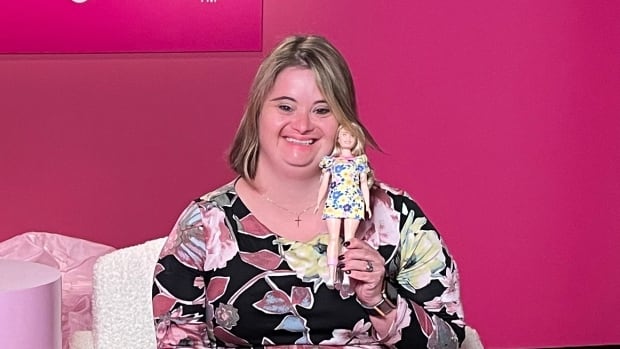As It Happens5:48Barbie with Down syndrome ‘looks just like me,’ says woman who helped design it
Kayla McKeon says seeing a Barbie that looks like her is an incredible feeling.
Earlier this week, Mattel unveiled its first Barbie doll with Down syndrome. And McKeon, a Down syndrome advocate who has the genetic condition herself, helped make it happen.
“The doll looks just like me,” McKeon, manager of grassoots advocacy with the U.S. National Down Syndrome Society (NDSS), told As It Happens host Nil Köksal.
“I’m going to keep mine where I can see it every day.”
The doll is the newest addition to Mattel’s Fashionistas collection, which reflects a wider diversity than the original Barbie lineup in terms of skin colour, hairstyle, body shape, ability and more.
“We are dedicated to doing our part to counter social stigma through play,” Lisa McKnight, executive vice-president and global head of Barbie and dolls at Mattel, said in a press release.
“Our goal is to enable all children to see themselves in Barbie, while also encouraging children to play with dolls who do not look like themselves. Doll play outside of a child’s own lived experience can teach understanding and build a greater sense of empathy, leading to a more accepting world.”
‘They definitely did it right’
Down syndrome is a genetic condition in which a person is born with an extra chromosome, changing the way the brain and the body develops.
An estimated 45,000 Canadians have Down syndrome, according to the Down Syndrome Association of Toronto.
WATCH | Model Ellie Goldstein ‘thrilled’ and ‘overwhelmed’ by new Barbie:
Mattel has unveiled its first Barbie with Down syndrome. British model Ellie Goldstein says: ‘It’s beautiful and I love it to pieces.’
When Mattel decided to make a Barbie with the condition, they turned to the NDSS for guidance. That’s where McKeon came in.
McKeon and her colleagues ensured the design accurately reflected the physical characteristics commonly associated with Down syndrome.
That means the doll is shorter in stature than most Barbies. She has small round ears, almond-shaped eyes, a flat nasal bridge and a single crease on her palms. She also sports orthotics, which some children with Down syndrome use to support their feet and ankles.
“They definitely did it right,” McKeon said. “They were just really receptive to what we had to say when it came down to the characteristics, because they got the characteristics down to a T.”

The doll also has some more symbolic features associated with Down syndrome. Her dress is blue and yellow, the colours of Down syndrome awareness.
Her pendant is three upward chevrons, representing three copies of the 21st chromosome, the genetic material that causes the characteristics associated with Down syndrome. It’s a design known as “the lucky few,” a reference people have someone with Down syndrome in their lives.
The symbol reminds McKeon of her connection to her own family and friends.
“It’s a link of all of us together,” she said.
‘I hope everybody plays with the doll’
McKeon is a prominent advocate for people with Down syndrome. She’s a Special Olympics medallist. She’s the first registered lobbyist in the U.S. with Down syndrome. And she hosts a NDSS podcast about her work in Washington, D.C.
“Representation is always pivotal,” she said. “We want to be seen in the community as valued members, because we absolutely are.”
Growing up, she says, she loved playing with Barbies.
“But there wasn’t a doll that looked like me necessarily. And that’s what I always hoped for,” she said.
But she says the doll isn’t just for people with Down syndrome.
“I hope everybody plays with the doll. When I was in school, I was included with my peers. So I’m hoping my peers and my friends are able to play with this doll as a symbol of diversity and inclusion today, which is just so huge.”



